Prysmian Bundle
Can Prysmian Group Maintain Its Momentum?
Prysmian Group, a titan in electric power and telecommunications, has consistently demonstrated remarkable growth since its inception in 1879. With a staggering €17 billion in sales in 2024 and a global footprint spanning over 50 countries, Prysmian's journey from a Milan-based startup to a global leader is a compelling narrative of strategic adaptation. The recent acquisition of Encore Wire for €4.1 billion marks a pivotal moment, signaling an ambitious expansion into new markets and technologies.
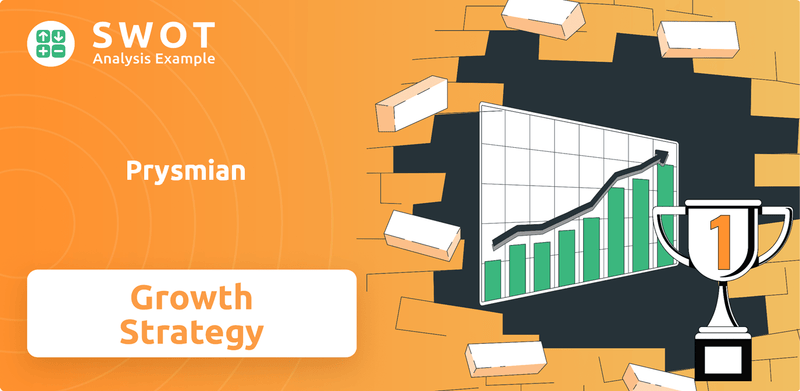
This analysis dives deep into Prysmian's Prysmian SWOT Analysis, exploring its ambitious Prysmian growth strategy, and assessing its future prospects within the dynamic landscape of the cable industry. We'll examine Prysmian's financial performance, strategic acquisitions, and innovation initiatives, providing insights into its competitive advantages and long-term growth potential. Furthermore, we'll explore Prysmian's role in the global power grid and its expansion plans in emerging markets, alongside its response to market challenges and commitment to sustainable growth.
How Is Prysmian Expanding Its Reach?
The Prysmian growth strategy is centered on expanding its market presence and diversifying its revenue streams through both organic growth and strategic acquisitions. This approach is designed to strengthen the company's position in key sectors like renewable energy and telecommunications. Recent acquisitions and significant investments in capacity expansion highlight Prysmian's commitment to long-term growth and its ability to adapt to evolving market demands.
Prysmian's future prospects look promising, driven by solid market trends in energy transition, electrification, and digitalization. The company’s strategic initiatives, including geographical expansion and capacity investments, are aimed at increasing its revenue from solutions. This focus is expected to drive significant growth and enhance Prysmian's competitive advantages in the cable industry.
Prysmian's financial performance is expected to be positively impacted by these strategic moves. The company's business strategy is focused on sustainable growth and innovation, positioning it well to capitalize on future opportunities. The company's investment in research and development further supports its long-term growth potential.
In July 2024, Prysmian acquired Encore Wire for €4.1 billion. This strategic move significantly strengthens Prysmian's presence in the U.S. market. The acquisition is expected to generate €140 million in EBITDA synergies by 2026.
Prysmian is set to acquire Channell, a U.S. firm specializing in high-voltage connectors, by mid-2025, for $1.15 billion. This acquisition will bolster Prysmian's Digital Solutions division. This acquisition is part of Prysmian's broader strategy to enhance its product offerings and market reach.
Prysmian plans cumulative capital expenditure of €2.6 billion between 2025 and 2028. A substantial portion of this investment is allocated to the Transmission business. These investments are crucial for meeting the growing demand in key sectors.
Over €100 million is being invested in the Pikkala, Finland, center for offshore wind farm cabling projects. Approximately €200 million will be invested in a high-voltage submarine cable facility in Massachusetts, USA, to support the offshore wind power industry. The Gron plant in France will also receive investment for German HVDC cable projects.
Prysmian aims to increase its revenue from solutions to over 55% by 2028, up from 28% in 2024. The company is capitalizing on market trends in energy transition, security, electrification, decarbonization, and digitalization. These trends are driving the demand for Prysmian's products and services.
- Geographical expansion, particularly in North America.
- Investments in capacity expansion to meet growing demand.
- Focus on sustainable growth and innovation.
- Strategic acquisitions to diversify revenue streams.
Prysmian SWOT Analysis
- Complete SWOT Breakdown
- Fully Customizable
- Editable in Excel & Word
- Professional Formatting
- Investor-Ready Format
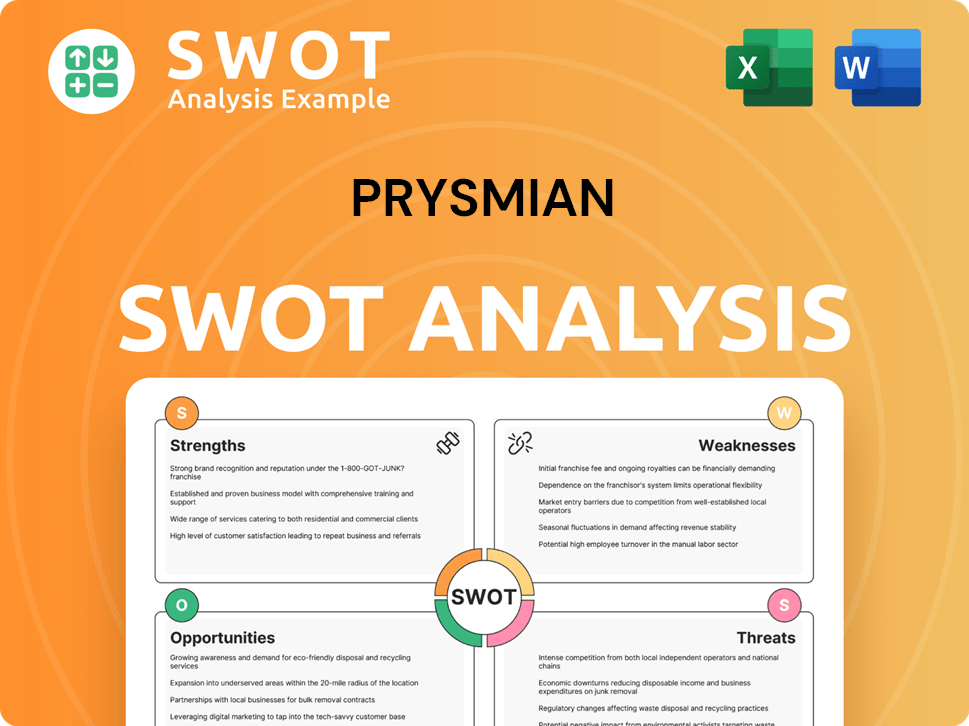
How Does Prysmian Invest in Innovation?
The company's innovation and technology strategy is central to its "Accelerating Growth" plan. This strategy focuses on transforming from a cable manufacturer to a solutions provider. The firm invests heavily in research and development to create cutting-edge products and services.
A key component of the strategy involves developing innovative and sustainable products. This includes solutions that enhance grid efficiency and reduce environmental impact. The company's commitment to sustainability is a significant driver of its innovation efforts.
The company's commitment to innovation is evident in its global presence of 27 R&D centers. These centers support the development of advanced cable technologies and digital solutions for power grid monitoring. The company's focus on sustainability and technological advancements positions it well for future growth.
The company offers products like E3X® Grid-Enhancing Technology and CL™ Advantage cable. These innovations aim to improve grid efficiency and reduce environmental impact. These products are designed to meet the growing demand for sustainable solutions.
The company utilizes PRY-CAM testing and monitoring technology. This technology is used for digital devices in power grid monitoring. This helps in enhancing grid reliability and efficiency.
The company is accelerating its sustainability targets. It aims to achieve Net Zero by 2035, significantly earlier than its original 2050 target. This includes reducing carbon emissions across its operations.
Prysmian plans a 60% reduction in Scope 1 and 2 carbon emissions by 2030. It also aims for a 65% reduction in Scope 3 emissions by 2030, compared to a 2019 baseline. These targets underscore its commitment to environmental responsibility.
The company aims for 55% of its revenues to come from sustainable solutions by 2028. This is an increase from 43% in 2024. This growth reflects the increasing importance of sustainable products in its business strategy.
In 2024, the company joined the Copper Mark initiative. This initiative promotes best practices in the copper value chain. It also increases sustainability audits for suppliers in 2025.
The company's innovation strategy is closely tied to its financial performance and market share. These initiatives support the company's long-term growth potential. The company's focus on innovation and sustainability is crucial for its Revenue Streams & Business Model of Prysmian.
- The company's commitment to reducing carbon emissions is a key part of its business strategy.
- The expansion of sustainable solutions is expected to drive revenue growth.
- The company's investment in R&D is essential for maintaining its competitive advantage.
- The company's focus on sustainability and innovation positions it well to respond to market challenges.
Prysmian PESTLE Analysis
- Covers All 6 PESTLE Categories
- No Research Needed – Save Hours of Work
- Built by Experts, Trusted by Consultants
- Instant Download, Ready to Use
- 100% Editable, Fully Customizable
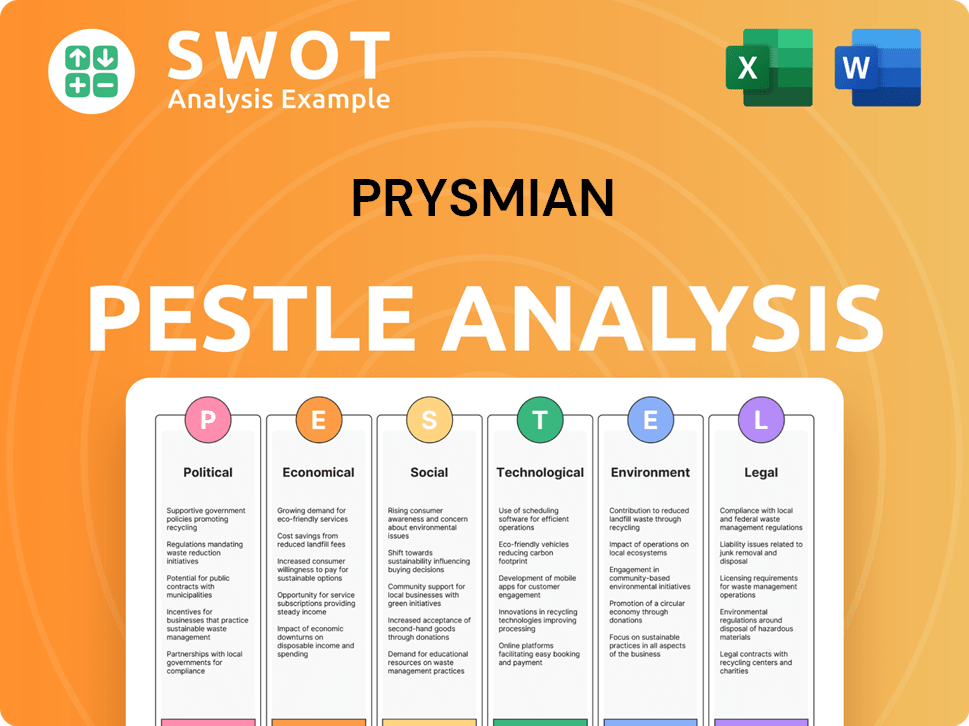
What Is Prysmian’s Growth Forecast?
The financial outlook for Prysmian Group is promising, driven by strategic initiatives and favorable market conditions. The company's Prysmian growth strategy focuses on expanding its market presence and enhancing operational efficiency. This approach is expected to yield strong financial results in the coming years, making the company a key player in the cable industry.
Prysmian's Prysmian future prospects are closely tied to the growth of renewable energy and telecommunications sectors. The company is well-positioned to capitalize on the increasing demand for advanced cable solutions in these areas. This strategic alignment with high-growth markets is a central part of their Prysmian business strategy.
For investors and stakeholders interested in understanding the company's core values, mission, and vision, a deeper dive can be found in this article: Mission, Vision & Core Values of Prysmian.
In 2024, Prysmian reported sales of €17.03 billion, demonstrating a solid financial foundation. The adjusted EBITDA reached €1.93 billion, marking an 18% year-over-year increase. Free cash flow also saw significant growth, increasing by 40% year-over-year to €1.01 billion.
For 2025, Prysmian anticipates continued growth. The adjusted EBITDA is forecasted to be between €2.25 billion and €2.35 billion. Free cash flow is projected to range from €950 million to €1.05 billion, reflecting the company's strong financial health and strategic investments.
By 2028, Prysmian aims for substantial growth. The adjusted EBITDA is targeted to be between €2.95 billion and €3.15 billion. Free cash flow is projected to reach between €1.5 billion and €1.7 billion, indicating the company's commitment to long-term value creation.
Adjusted Earnings Per Share (EPS) is expected to rise to €4.60-€5.20 per share in 2028. The Return on Capital Employed (ROCE) is targeted between 20% and 22%. The company plans to maintain a healthy financial structure by reducing its net debt/Adjusted EBITDA ratio to 1.0x-1.5x.
Capital expenditure over the 2025-2028 period is expected to total €2.6 billion. This investment, averaging €650 million per year, will primarily focus on the Transmission business, supporting future growth and market leadership.
Prysmian plans to progressively increase its dividend per share by approximately 12% year-on-year. The company will allocate around €1.1 billion to dividends during 2025-2028, reflecting its confidence in future earnings and commitment to shareholder returns.
Strategic acquisitions play a key role in Prysmian's growth strategy. These acquisitions help expand market share and enhance Prysmian's competitive advantages in the cable industry. The company's financial performance is expected to benefit from these strategic moves.
Prysmian is well-positioned to take advantage of favorable market trends, particularly in renewable energy and telecommunications. The increasing demand for advanced cable solutions in these sectors supports Prysmian's long-term growth potential. The company's focus on innovation in fiber optic cables further strengthens its market position.
Prysmian aims to strengthen its financial structure by reducing its net debt/Adjusted EBITDA ratio. This strategic move enhances the company's financial stability and supports its ability to invest in future growth initiatives. The focus on sustainable growth is a key part of Prysmian's strategy.
Prysmian's competitive advantages include its strong market position, innovative product offerings, and strategic acquisitions. These factors contribute to Prysmian's Prysmian market share and overall success. The company's response to market challenges is another key strength.
Prysmian Business Model Canvas
- Complete 9-Block Business Model Canvas
- Effortlessly Communicate Your Business Strategy
- Investor-Ready BMC Format
- 100% Editable and Customizable
- Clear and Structured Layout
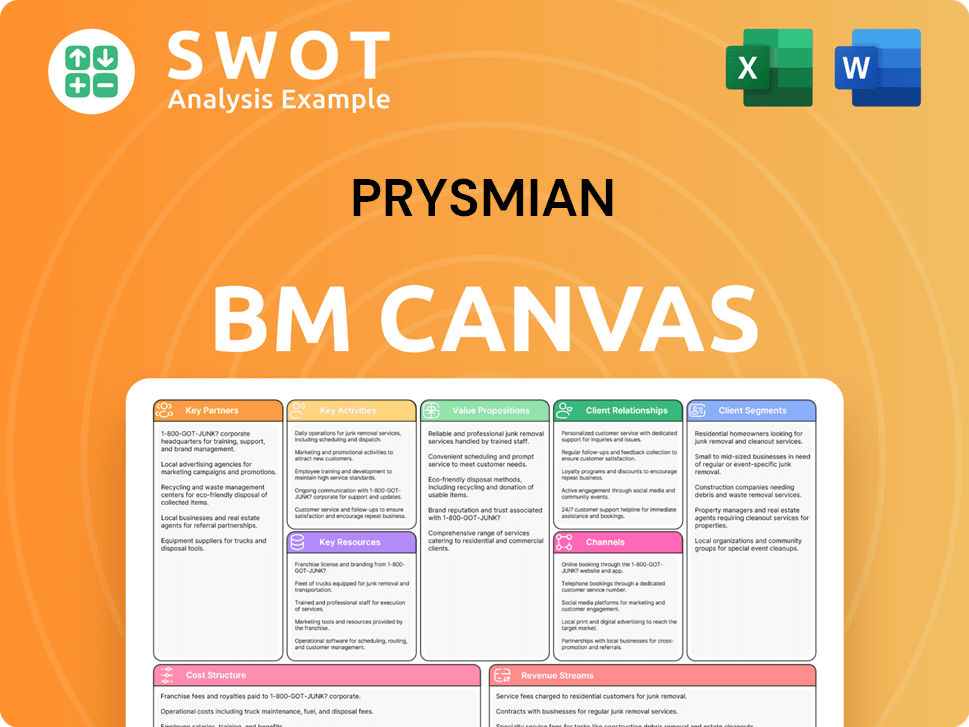
What Risks Could Slow Prysmian’s Growth?
The Prysmian growth strategy faces several risks and obstacles that could influence its future prospects. Market competition, particularly in the sustainable products sector, demands continuous innovation to maintain and enhance its market share. Fluctuations in metal prices, such as copper and aluminum, pose a threat to cost structures and profit margins, although Prysmian aims to pass these costs to its customers.
Macroeconomic uncertainties and geopolitical tensions could affect demand in key markets and disrupt supply chains. The company's recent acquisitions, funded by debt, have increased its financial debt significantly. This situation requires careful financial management to ensure the company maintains its investment-grade rating and avoids over-leverage.
Delays in integrating acquired companies and the challenge of reducing Scope 3 emissions further complicate the landscape. Despite these challenges, Prysmian is focused on diversification, its strong project pipeline, and technological advantages. These strategies are designed to mitigate risks and support the company's long-term growth potential.
Intense competition, especially in sustainable products, necessitates constant innovation. Prysmian must continuously develop new technologies and products to maintain its competitive edge. This requires significant investment in research and development to stay ahead of rivals and maintain its market share.
Fluctuations in metal prices, such as copper and aluminum, can significantly impact cost structures. These variations can disrupt profit margins if not managed effectively. Prysmian aims to pass these costs to customers, but this strategy may not always be feasible, especially in competitive markets.
Macroeconomic uncertainties and geopolitical tensions can influence demand and supply chain stability. Economic downturns or political instability in key markets can reduce demand for Prysmian's products. Supply chain disruptions can also increase costs and delay projects.
Recent acquisitions have increased Prysmian's net financial debt, which reached €4.88 billion in Q1 2025. Managing this debt burden is critical to avoid over-leverage. The company's financial policy targets a leverage ratio not exceeding 1.5x, though it could go up to 2.0x for future acquisitions.
Delays in integrating acquired entities, like Channell, can pressure margins and cash flow. Successfully integrating new businesses is crucial for realizing expected synergies and financial benefits. Efficient integration is essential for maintaining profitability and achieving strategic goals.
Reducing Scope 3 emissions across the value chain is an ongoing challenge for Prysmian. Meeting sustainability goals requires significant investments and operational changes. Addressing these emissions is vital for long-term sustainability and aligning with global environmental standards.
Prysmian mitigates risks through diversification across various sectors and geographies. The company's strong project pipeline and technological edge provide competitive advantages. Focus on innovation and strategic acquisitions supports long-term growth and resilience in the face of market challenges.
Maintaining an investment-grade rating is a key priority for Prysmian. The company's financial policy emphasizes disciplined management of its debt. Generating robust free cash flow is essential for deleveraging and ensuring financial stability. This approach is critical for supporting Prysmian's financial performance.
Prysmian Porter's Five Forces Analysis
- Covers All 5 Competitive Forces in Detail
- Structured for Consultants, Students, and Founders
- 100% Editable in Microsoft Word & Excel
- Instant Digital Download – Use Immediately
- Compatible with Mac & PC – Fully Unlocked
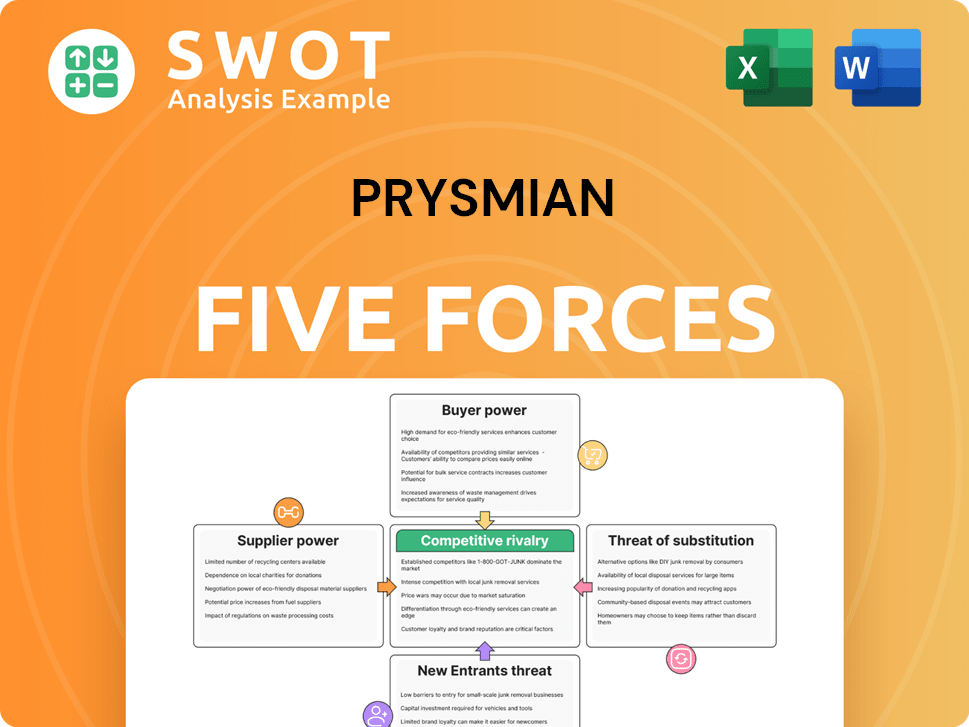
Related Blogs
- What are Mission Vision & Core Values of Prysmian Company?
- What is Competitive Landscape of Prysmian Company?
- How Does Prysmian Company Work?
- What is Sales and Marketing Strategy of Prysmian Company?
- What is Brief History of Prysmian Company?
- Who Owns Prysmian Company?
- What is Customer Demographics and Target Market of Prysmian Company?
Disclaimer
All information, articles, and product details provided on this website are for general informational and educational purposes only. We do not claim any ownership over, nor do we intend to infringe upon, any trademarks, copyrights, logos, brand names, or other intellectual property mentioned or depicted on this site. Such intellectual property remains the property of its respective owners, and any references here are made solely for identification or informational purposes, without implying any affiliation, endorsement, or partnership.
We make no representations or warranties, express or implied, regarding the accuracy, completeness, or suitability of any content or products presented. Nothing on this website should be construed as legal, tax, investment, financial, medical, or other professional advice. In addition, no part of this site—including articles or product references—constitutes a solicitation, recommendation, endorsement, advertisement, or offer to buy or sell any securities, franchises, or other financial instruments, particularly in jurisdictions where such activity would be unlawful.
All content is of a general nature and may not address the specific circumstances of any individual or entity. It is not a substitute for professional advice or services. Any actions you take based on the information provided here are strictly at your own risk. You accept full responsibility for any decisions or outcomes arising from your use of this website and agree to release us from any liability in connection with your use of, or reliance upon, the content or products found herein.